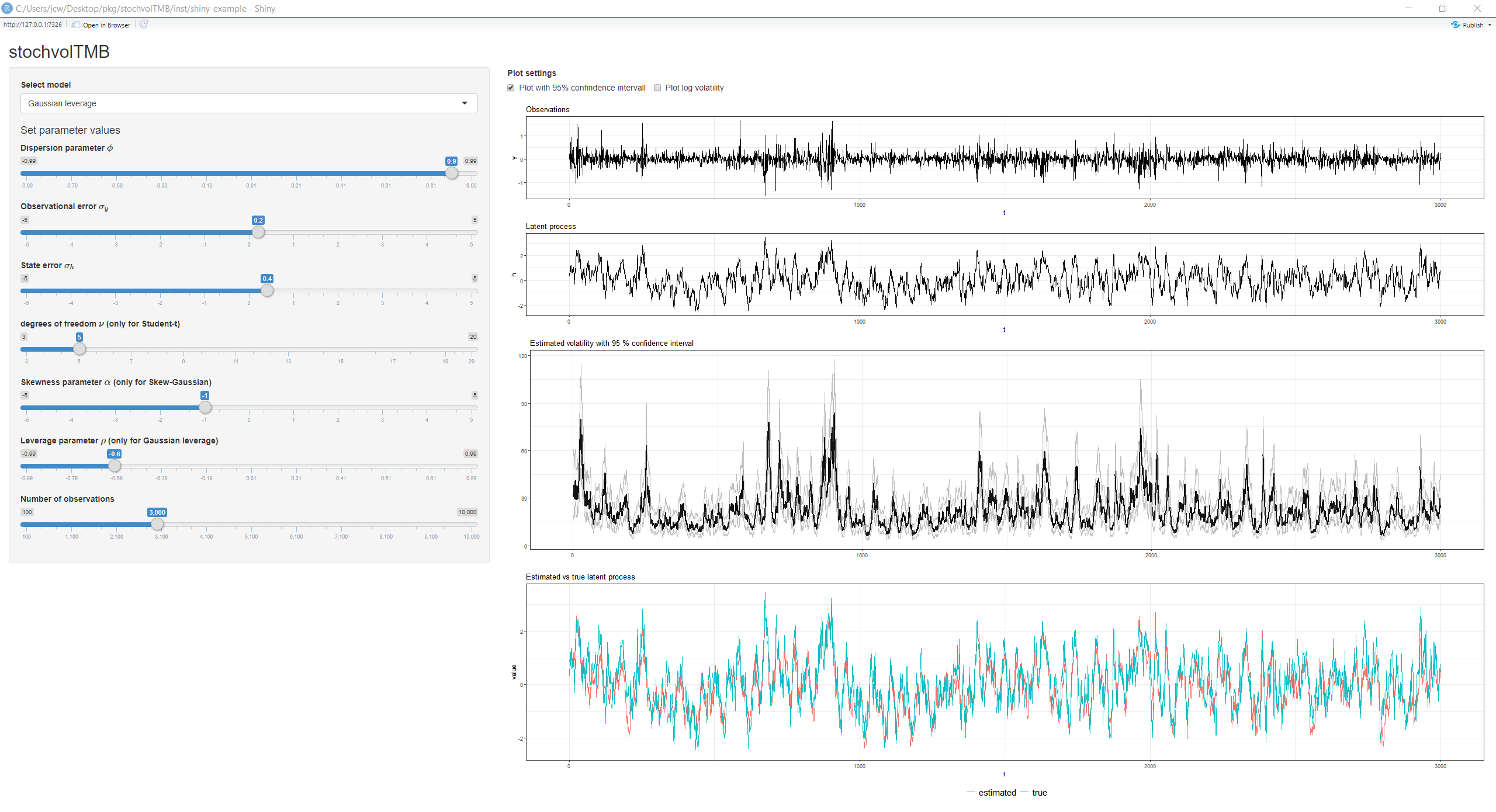

stochvolTMB is a package for fitting stochastic
volatility (SV) models to time series data. It is inspired by the
package stochvol, but
parameter estimates are obtained through optimization and not MCMC,
leading to significant speed up. It is built on Template Model Builder for
fast and efficient estimation. The latent volatility is integrated out
of the likelihood using the Laplace approximation and automatic
differentiation (AD) is used for accurate evaluation of derivatives.
Four distributions for the observational error are implemented:
To install the current stable release from CRAN, use
install.packages("stochvolTMB")To install the current development version, use
# install.packages("remotes")
remotes::install_github("JensWahl/stochvolTMB")If you would also like to build and view the vignette locally, use
remotes::install_github("JensWahl/stochvolTMB", dependencies = TRUE, build_vignettes = TRUE)The main function for estimating parameters is
estimate_parameters:
library(stochvolTMB, warn.conflicts = FALSE)
# load s&p500 data from 2005 to 2018
data(spy)
# find the best model using AIC
gaussian <- estimate_parameters(spy$log_return, model = "gaussian", silent = TRUE)
t_dist <- estimate_parameters(spy$log_return, model = "t", silent = TRUE)
skew_gaussian <- estimate_parameters(spy$log_return, model = "skew_gaussian", silent = TRUE)
leverage <- estimate_parameters(spy$log_return, model = "leverage", silent = TRUE)
# the leverage model stands out with an AIC far below the other models
AIC(gaussian, t_dist, skew_gaussian, leverage)
#> df AIC
#> gaussian 3 -23430.57
#> t_dist 4 -23451.69
#> skew_gaussian 4 -23440.87
#> leverage 4 -23608.85
# get parameter estimates with standard error
estimates <- summary(leverage)
head(estimates, 10)
#> parameter estimate std_error z_value p_value type
#> 1: sigma_y 0.008338412 0.0004163314 20.0283029 3.121144e-89 transformed
#> 2: sigma_h 0.273443559 0.0182641070 14.9716359 1.125191e-50 transformed
#> 3: phi 0.967721215 0.0043681868 221.5384240 0.000000e+00 transformed
#> 4: rho -0.748695259 0.0322487815 -23.2162340 3.121690e-119 transformed
#> 5: log_sigma_y -4.786882463 0.0499293427 -95.8731319 0.000000e+00 fixed
#> 6: log_sigma_h -1.296660043 0.0667929683 -19.4131220 5.978190e-84 fixed
#> 7: logit_phi 4.110221202 0.1375467861 29.8823500 3.337032e-196 fixed
#> 8: logit_rho -1.939958912 0.1467670249 -13.2179481 6.912403e-40 fixed
#> 9: h -0.536254072 0.5182192669 -1.0348015 3.007616e-01 random
#> 10: h -0.207811236 0.4245258952 -0.4895137 6.244781e-01 random
# plot estimated volatility with 95 % confidence interval
plot(leverage, include_ci = TRUE, dates = spy$date)
Given the estimated parameters we can simulate future volatility and
log-returns using predict.
set.seed(123)
# simulate future prices with or without parameter uncertainty
pred = predict(leverage, steps = 10)
# Calculate the mean, 2.5% and 97.5% quantiles from the simulations
pred_summary = summary(pred, quantiles = c(0.025, 0.975), predict_mean = TRUE)
print(pred_summary)
#> $y
#> time quantile_0.025 quantile_0.975 mean
#> 1: 1 -0.03787452 0.03639606 -2.352005e-04
#> 2: 2 -0.03750167 0.03718038 7.938422e-05
#> 3: 3 -0.03759011 0.03677040 -6.930858e-05
#> 4: 4 -0.03667977 0.03841486 2.810659e-04
#> 5: 5 -0.03674431 0.03679402 -1.421016e-04
#> 6: 6 -0.03531571 0.03708404 2.750826e-04
#> 7: 7 -0.03706161 0.03531337 -9.648350e-05
#> 8: 8 -0.03654679 0.03581507 -9.638224e-05
#> 9: 9 -0.03558469 0.03600052 -7.431832e-05
#> 10: 10 -0.03551163 0.03483791 -3.915279e-04
#>
#> $h
#> time quantile_0.025 quantile_0.975 mean
#> 1: 1 0.41447216 2.519873 1.455147
#> 2: 2 0.27225022 2.568749 1.408390
#> 3: 3 0.10808006 2.612277 1.363972
#> 4: 4 0.01248118 2.639010 1.322519
#> 5: 5 -0.12153490 2.658716 1.276073
#> 6: 6 -0.20817536 2.688433 1.239662
#> 7: 7 -0.28558724 2.696168 1.199534
#> 8: 8 -0.37711849 2.699062 1.160366
#> 9: 9 -0.46776638 2.718274 1.124317
#> 10: 10 -0.55249774 2.705546 1.086525
#>
#> $h_exp
#> time quantile_0.025 quantile_0.975 mean
#> 1: 1 0.010125271 0.02945742 0.01790539
#> 2: 2 0.009421133 0.03039987 0.01765869
#> 3: 3 0.008772480 0.03099832 0.01736513
#> 4: 4 0.008319762 0.03130376 0.01715038
#> 5: 5 0.007848844 0.03163646 0.01677779
#> 6: 6 0.007459083 0.03191093 0.01657714
#> 7: 7 0.007125009 0.03202311 0.01631264
#> 8: 8 0.006833992 0.03228772 0.01612161
#> 9: 9 0.006592298 0.03264210 0.01588995
#> 10: 10 0.006231481 0.03240400 0.01567428
# plot predicted volatility with 0.025 and 0.975 quantiles
plot(leverage, include_ci = TRUE, forecast = 50, dates = spy$d) +
ggplot2::xlim(c(spy[.N, date] - 150, spy[.N, date] + 50))
#> Warning: Removed 3419 row(s) containing missing values (geom_path).
#> Warning: Removed 3419 row(s) containing missing values (geom_path).
#> Warning: Removed 3419 row(s) containing missing values (geom_path).
By running demo() you start a shiny application where
you can visually inspect the effect of choosing different models and
parameter configurations
demo()